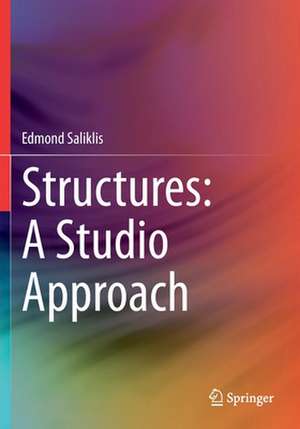Structures: A Studio Approach
Autor Edmond Saliklisen Limba Engleză Paperback – 3 mar 2021
Structures: A Studio Approach reaches out to both structural engineers and designers by presenting structural engineering topics in an interdisciplinary studio environment. Using many graphical techniques, it offers a very rigorous approach, but also enables creativity. Cutting edge finite element as well as parametric modeling tools are used, and state of the art visual representations of force flow help both groups of students realize that understanding three dimensional load flow in a building is a requirement for channeling that flow in a structurally efficient and visually expressive manner. Ultimately, the reader is able to develop a unique structural sensibility; an ethos that places structural design on an equal footing with the design of program, skin, massing and site.
| Toate formatele și edițiile | Preț | Express |
|---|---|---|
| Paperback (1) | 396.40 lei 6-8 săpt. | |
| Springer International Publishing – 3 mar 2021 | 396.40 lei 6-8 săpt. | |
| Hardback (2) | 485.78 lei 6-8 săpt. | |
| Springer International Publishing – 3 mar 2020 | 485.78 lei 6-8 săpt. | |
| Springer International Publishing – 16 noi 2018 | 713.23 lei 6-8 săpt. |
Preț: 396.40 lei
Nou
Puncte Express: 595
Preț estimativ în valută:
75.85€ • 82.65$ • 63.92£
75.85€ • 82.65$ • 63.92£
Carte tipărită la comandă
Livrare economică 23 aprilie-07 mai
Preluare comenzi: 021 569.72.76
Specificații
ISBN-13: 9783030331559
ISBN-10: 3030331555
Pagini: 340
Ilustrații: IX, 340 p. 496 illus., 376 illus. in color.
Dimensiuni: 178 x 254 mm
Greutate: 0.61 kg
Ediția:1st ed. 2020
Editura: Springer International Publishing
Colecția Springer
Locul publicării:Cham, Switzerland
ISBN-10: 3030331555
Pagini: 340
Ilustrații: IX, 340 p. 496 illus., 376 illus. in color.
Dimensiuni: 178 x 254 mm
Greutate: 0.61 kg
Ediția:1st ed. 2020
Editura: Springer International Publishing
Colecția Springer
Locul publicării:Cham, Switzerland
Cuprins
1. Introduction.- 2. Loads.- 3. Dead Load Flow.- 4. Dead Load, Live Load.- 5. Earthquake Loads.- 6. Trusses.- 7. Flexible Diaphragms.- 8. Rigid Diaphragms.- 9. Load Flow in Significant Buildings.- 10. Frame Refinement.- 11. Shells in the Studio.
Notă biografică
Dr. Edmond P. Saliklis is a professor in the architectural engineering department at California Polytechninc State University. He specializes in Structural Art, Graphical Statics and Constitutive Modeling of Orthotropic Materials. He hold an M.S. in Civil Engineering from Syracuse University and a Ph.D. in Civil Engineering from the University of Wisconsin, Madison. He is the author of the companion book, Structures: A Geometric Approach, also published by Springer.
Textul de pe ultima copertă
Understanding how gravity loads and wind and earthquake loads flow through a building is of utmost importance to all structural engineers and architects. Paradoxically, this critical idea is practically not addressed in any textbook on the market. Meant as a companion to the author’s Structures: A Geometric Approach, this textbook fills that need with qualitative techniques as well as quantitative tools that use state of the art visual representation of forces and deformations in structures.
Structures: A Studio Approach reaches out to both structural engineers and designers by presenting structural engineering topics in an interdisciplinary studio environment. Using many graphical techniques, it offers a very rigorous approach, but also enables creativity. Cutting edge finite element as well as parametric modeling tools are used, and state of the art visual representations of force flow help both groups of students realize that understanding three dimensional load flow in a building is a requirement for channeling that flow in a structurally efficient and visually expressive manner. Ultimately, the reader is able to develop a unique structural sensibility; an ethos that places structural design on an equal footing with the design of program, skin, massing and site.
Structures: A Studio Approach reaches out to both structural engineers and designers by presenting structural engineering topics in an interdisciplinary studio environment. Using many graphical techniques, it offers a very rigorous approach, but also enables creativity. Cutting edge finite element as well as parametric modeling tools are used, and state of the art visual representations of force flow help both groups of students realize that understanding three dimensional load flow in a building is a requirement for channeling that flow in a structurally efficient and visually expressive manner. Ultimately, the reader is able to develop a unique structural sensibility; an ethos that places structural design on an equal footing with the design of program, skin, massing and site.
Caracteristici
There are three fundamental techniques used to quantitatively and qualitatively explore load flow in this studio environment Graphical analysis tools that solely use geometry, not algebra, to analyze and design. This is broadly known as graphic statics, but this textbook uses more of the qualitative understanding of where a funicular would lie in relation to the designed form, and how far the funicular is from the centerline of the structure Finite element tools such as SAP2000. Readers are guided in setting up models, the use of such models and given the means to roughly check the validity of their results via the graphical techniques previously described as well as by the following tool. The visualization of load flow afforded by these programs is unmatched and certainly outweighs any drawbacks to such an approach Parametric modeling in Karamba, which is a plugin for Grasshopper (part of the Rhino Suite). This state of the art tool is already being explored by students and practitioners. It is necessary and timely to harness and channel the energy and excitement surrounding this state of the art tool
